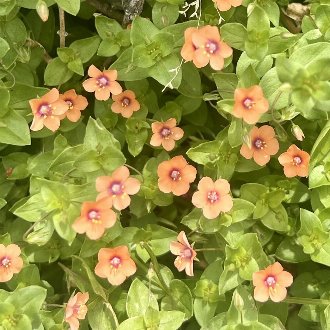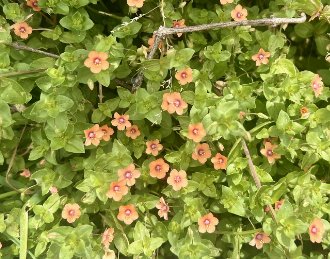Scarlet Pimpernel (Lysimachia arvensis (L.) U.Manns & Anderb.)
Also known as red pimpernel, red chickweed, poor man's barometer, poor man's weather-glass, shepherd's weather glass, shepherd's clock; also classified as Anagallis arvensis L.
↑Summary
A small annual with distinctive coral-red flowers, native to Europe, western Asia and North Africa, and introduced in North America.
↑Range - Expand
| Legend | Color |
| Introduced | |
| Introduced or Not Present |
This tentative map is based on our own research. It may have limited data on Canada and/or Mexico, and there is some subjectivity in our assignment of plants as introduced vs. expanded. Read more in this blog post.
Although this plant occurs somewhere in each of these regions, it may only occur in a small part of some or all of them.
↑Habitat
Scarlet pimpernel is found in open, disturbed habitats. It is most common in anthropogenic habitats, including lawns, pastures, occasionally-mowed fields, roadsides, and waste ground. It can survive regular mowing and also occasional mowing or weedwhacking, but it is usually absent from sites that are allowed to grow up with taller vegetation.
It grows best on sites with full sun or at least a significant amount of direct sunlight, and is less common in partly-shaded habitats and absent from areas with a closed canopy. We found conflicting reports of its moisture preferences; USDA PLANTS classifies it either as an obligate upland plant, or facultative upland plant, which usually means it prefers drier conditions, but Missouri Plants says it is usually found in moist soil.
It requires well-drained surface soil, with a loamy to sandy texture, but is shallow-rooted and is indifferent to lower levels so long as water does not pool on a site, so it can occur on areas where a thin layer of well-aerated sandy or loamy surface soil is underlain by fine clay or compacted soil.
In its native range, it often grows on limestone cliffs and open areas on limestone substrates where there are significant rock outcroppings and soil is relatively poorly-developed. However it is not reported on limestone barrens in North America.
↑Life Cycle
Scarlet pimpernel is a mat-forming annual that relies on vegetative reproduction during the growing season, and seeds to survive to the next season. It forms a fibrous root system, and can root at nodes to establish new root systems.
Plants are opportunistic about flowering and the bloom period in long. Typically there is a peak some time in April-June, with the peak occurring earlier in the south of the range and later in the north, but significant number of blooms occur later in summer. In the warmest parts of the continent, some blooming can occur year-round. Plants continue blooming and producing seeds incrementally as conditions allow.
Flowers require high light conditions to open and stay open. They tend to close at night and often remain closed on cloudy days.
The end of seed production and death of the plant can occur by may different means, including summer drought, fall or winter cold, or mechanical disturbance such as plowing or tilling in cropland, or any other anthropogenic clearing of vegetation that destroys most of the plant. It can survive standard mowing. In richer conditions in the absence of disturbance, the plant can also be shaded out later in the season as it gets overtaken by taller vegetation. Usually the plant is able to produce seeds before dying.
↑Faunal Associations
This plant usually resists browsing by mammalian herbivores.
Although few insects feed on this plant in North America, it has been reported being eaten by the ailanthus silkmoth (Samia cynthia), and the related moth Samia walkeri, both of which are native to Asia and introduced in North America.
↑Control
This species can be relatively difficult to control intentionally, but it also rarely tends to dominate. With small populations, individual plants can be pulled by hand. This usually does not completely eliminate it, because its seed production is incremental, but it can reduce seed production and reduce its numbers long-term.
For larger sites where this plant is dominant over a large scale, the best control is usually to refrain from whatever disturbance is favoring this plant. It usually cannot establish and survive long-term unless some sort of disturbance continually favors it. Exclusion of mamamlian herbivores may also reduce its numbers, as it tends to be favored by herbivory as mammals tend to eat a lot of other plants before they will turn to this one.
In natural lawns, untreated by selective herbicides, this plant can be reduced or excluded by the seeding or encouraging of other broadleaf plants that outcompete it, such as violets (Viola sp.). Violets are particularly effective as they emerge earlier and will prevent germination and establishment of this plant. Taking care to reduce erosion or bare patches in lawn will also reduce the small gaps that this plant uses to germinate and establish.
In garden beds, the use of groundcovers and the allowing of plants to fill in a bed can also reduce the opportunities for this plant to germinate and establish.
↑Uses
This species has occasionally been used as a garden plant, primarily in more wild or naturalized areas, where it is valued for its cute, uniquely-colored flowers. Even less frequently, it has been used for medicinal properties.
We recommend against planting it because, although it is not usually considered invasive in North America, and it usually remains relatively uncommon in the wild, it does not support the food web much, and it contributes to there being lower biodiversity in the anthropogenic habitats where it is most dominant.
↑Related Plants
Numerous other Lysimachia species occur in North America, both native and introduced. It is probably closest-related to blue pimpernel (Lysimachia monelli), which is also introduced, and primarily found as a garden plant, and also Lysimachia loeflingii, with which it hybridizes.
Although scarlet pimpernel is visually-similar to chickweeds (Stellaria) and some common names refer to it as a "chickweed", the resemblance is superficial and is a case of convergent evolution. Only the foliage and growth habit are similar; the flower structures are wildly dissimilar. The plants are not even in the same order, with scarlet pimpernel belonging to the Ericales and true chickweeds to the Caryophyllales.
↑Notes
The common names "poor-man’s weatherglass", "poor-man’s barometer", and "shepherd’s clock" all reference the tendency of this plant's flowers to close in cool, cloudy conditions. Although we could not find a scientific source studying the mechanism, a times article reports that this phenomenon is triggered by dropping temperatures on the petals, which is often triggered by the darkening of the sky that precedes a storm. If this assertion is true, the plant is not a true barometer and its flower closure only correlates with storms, not providing any additional information that could not be easily observed with the eye.
↑Links & External Resources
• Anagallis arvensis (Scarlet Pimpernel) | USDA PLANTS Database (About This Site)
• Scarlet Pimpernel | iNaturalist (About This Site)
• Lysimachia arvensis | Biota of North America Project (BONAP) (About This Site)
• Lysimachia arvensis | Go Botany (About This Site)
• Anagallis arvensis | NatureServe Explorer (About This Site)
• Anagallis arvensis | Flora of North America (About This Site)
• Anagallis arvensis | Missouri Plants (About This Site)
• Scarlet Pimpernel | Maryland Biodiversity Project (About This Site)
• Anagallis arvensis L. (Scarlet Pimpernel, Common Pimpernel) | Digital Atlas of the Virginia Flora (About This Site)
• Lysimachia arvensis (L.) U.Manns & Anderb. | Plants of the World Online (POWO) (About This Site)




